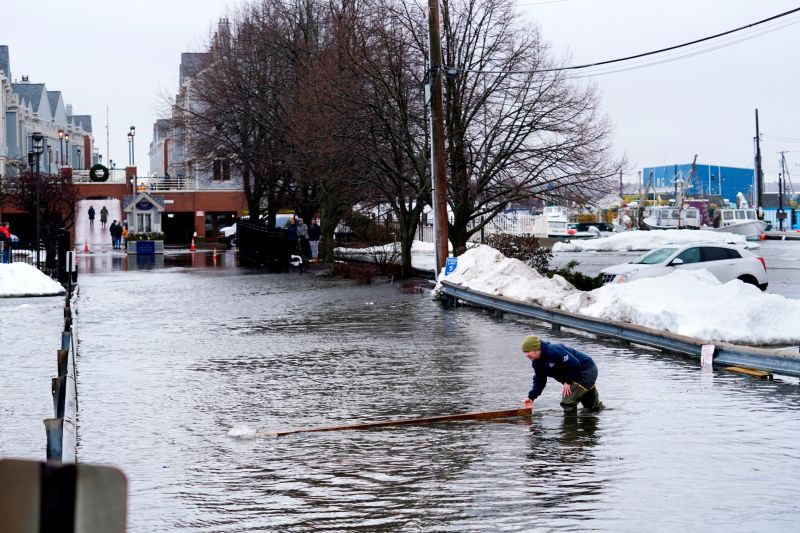Across much of northern New England, winter has been painfully late – and rainy.
Though the weather is about to turn more solidly cold, hardy New Englanders are bemoaning a start to the winter that’s so far been characterized by fog, rain and warmer temperatures – conditions that have dealt a blow to the region’s recreational lifeblood, including snowmobiling, ice fishing and skiing.
When Vermont state fisheries biologist Shawn Good looks out at popular lakes that should be frozen solid by early January, he’s seen open water and winter anglers fishing in boats. The ice just hasn’t been there.
“On January 12, it’s absolutely crazy to have some of our most popular lakes for ice fishing have open water, but that’s the situation right now,” Good said in a Friday interview. “We get these freeze-thaw cycles continuing to come around. We are seeing more people out fishing in boats right now than we’re seeing people fishing on the ice.”
The warmer temperatures mean precipitation that could be snow is falling as rain. After enduring a historically wet summer last year, New Englanders got only more record-breaking rain in December. A massive coastal storm walloped the region, turning rivers into raging torrents and cutting power to over 800,000 people.
That storm wreaked havoc on the Maine Snowmobile Association’s 14,000-mile network of trails, which it had just finished rebuilding from spring and summer washouts.
That storm brought down trees and washed out bridges, Swett said, severe enough damage that repairs won’t be able to start in earnest until this summer.
On top of the hit to the trail system, there has been very little snow, save for a few corners of the state. Although some snowmobile clubs in Maine are starting to get enough snow to get back out on the trails, Swett said he fears that will lead to crowded trails with more people riding in fewer areas – a concern for rider safety.
Swett says winter in New England has changed significantly over his lifetime.
“It’s not cold like it used to be in my day,” Swett said. “Back in the day we had a couple days of a January thaw, then it went back into winter, but that hasn’t happened. Global warming, I don’t know what else it would be. It’s pretty sad.”
A rainy start to the ski season
There is a certain kind of pride to East Coast skiing – being not only able, but eager, to navigate icy patches, tight turns and steep vertical drops on bitterly cold days.
Skiing in wet snow is significantly less fun.
“We’ve gotten too much rain, way too much rain,” said Ry Young, marketing and events manager at Mad River Glen – a cooperative ski resort in Vermont. “The temperature swings, the amount of moisture that’s coming with them, they’re all increasing. It wasn’t a huge surprise this year to see these storms come through and continue to drop these massive amounts of water on us.”
Smaller amounts of rain or wet snow can actually be beneficial to help build up a solid base on mountains, Young said. But too much rain can be a disaster.
“If you put a groomer on wet snow and it freezes, then you’re just going to end up with solidified corduroy,” Young said. In other words: “It’s going to be a solid frozen sheet of ice.”
“It can’t be understated that it’s been a bit of a roller coaster of a weather pattern,” said Brandon Swartz, general manager of Attitash Mountain in New Hampshire. Swartz said his teams try to “strike while the cold is here” and maximize “every window of opportunity we have” to make snow.
Manmade snow “can take more of a beating” from rain, Swartz said, because it is denser than natural snow and water can flow through it more easily. That has meant that even strong rainstorms haven’t washed all the snowpack away, letting crews at Attitash and other resorts not have to start their snowmaking operations completely from scratch.
“It’s really come down to the improvements of the technology to help us navigate challenging times,” said JD Crichton, general manager at Wildcat Mountain in northern New Hampshire (Wildcat and Attitash are both owned by Vail Resorts).
But some skiing operations in northern New England can’t take advantage of snowmaking. In Littleton, New Hampshire, a small rope-tow operation called the Mt. Eustis ski hill has been sitting dormant – waiting for enough natural snow to open.
Skiing is an expensive sport, and unlike most resorts in the area, Mt. Eustis costs $5 per day – a suggested donation. After being closed for years, it reopened in 2016 to try to make skiing more cost-effective and accessible for locals. But its volunteers say its season is getting shorter, entirely dependent on the whims of warming winters.
“We’re trying to be hopeful but there’s nothing we can do,” said John Tully, vice president of the operation’s board of directors. “It’s just a waiting game. Last week it was [forecasted] that we were going to get this huge storm and it just ended up being rain.”
Attitash recently donated one of its grooming machines to Mt. Eustis, but it has just been sitting unused as everyone waits for consistent snow. And the ski hill’s board of directors has started talking about how they could diversify their operations in warmer seasons – trying to sustain it in the spring and summer for lack of winter snow.
In New England, people often make small talk about the weather, and there’s been no shortage of grumbling about the winter rain, Tully said.
“There is this sort of feeling that we got a lot of rain, if this was only snow,” he said. “With the hottest year being this past year, things are definitely changing. We see it, we feel it.”






































